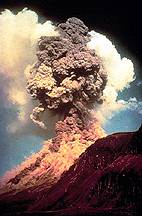

  |
Volcanic Hazards Ash
flows are dense masses of gas and tiny fragments of lava that flow down the sides of
volcanoes at great speeds. Much less well known (and understood) than lava flows or
explosive blasts, ash flows are a combination of a blast cloud and a lava flow. They form
when gas-saturated lava comes near the surface of the Earth and the pressure in the lava
becomes low enough to allow the dissolved gas to form bubbles. If the bubbles form fast
enough, the lava breaks into tiny fragments of liquid rock (called ash) that are carried
out of the surface vent with the gas. If the ratio of gas to fragments is large (lots of
gas), the ash is carried by the gas into blast clouds that can reach the upper atmosphere.
If the ratio of gas to ash is small (lots of fragments), the ash can drag the gas downward
into red-hot flows. These red-hot flows are partially controlled by gravity, and since the
gas makes the friction between the ash particles very small, they can flow very far (up to
hundreds of miles), very fast (over 100 mph). The relatively small red-hot ash flows
that have been seen by geologists are called glowing avalanches because of their
similarities to snow avalanches. Photo: Courtesy of NGDC/NOAA Ash
flows are dense masses of gas and tiny fragments of lava that flow down the sides of
volcanoes at great speeds. Much less well known (and understood) than lava flows or
explosive blasts, ash flows are a combination of a blast cloud and a lava flow. They form
when gas-saturated lava comes near the surface of the Earth and the pressure in the lava
becomes low enough to allow the dissolved gas to form bubbles. If the bubbles form fast
enough, the lava breaks into tiny fragments of liquid rock (called ash) that are carried
out of the surface vent with the gas. If the ratio of gas to fragments is large (lots of
gas), the ash is carried by the gas into blast clouds that can reach the upper atmosphere.
If the ratio of gas to ash is small (lots of fragments), the ash can drag the gas downward
into red-hot flows. These red-hot flows are partially controlled by gravity, and since the
gas makes the friction between the ash particles very small, they can flow very far (up to
hundreds of miles), very fast (over 100 mph). The relatively small red-hot ash flows
that have been seen by geologists are called glowing avalanches because of their
similarities to snow avalanches. Photo: Courtesy of NGDC/NOAA
Rock/Debris avalanches are masses of cold, dry rock that have broken free from the sides of a volcano. They are driven downslope by gravity, smashing everything in their path by the force of their motion and then burying what remains under a mass of rock and debris. A good example of a rock avalanche triggered by an eruption is the mass of rock that broke off the north face of Mount St. Helens and buried the valleys to the north. However, an eruption is not needed to trigger a rock avalanche. Simple undermining of a mass of rock or an earthquake unrelated to an eruption can start a rock avalanche. Of course, such rock avalanches can occur on any steep mountain slope, but volcanoes are particularly prone to rock avalanches because their sides consist of outward-sloping layers of solid and fragmental rock (it is easier to slide down a sloping tabletop than across the ends of a bunch of stacked tables), and volcanic rock is easily changed by water into slippery clay, which promotes failure and sliding.
[ Volcanoes & Climate ] [ Monitoring Volcanoes ] [ Home ] [ Teacher Pages ] [ Modules & Activities ] |
HTML code by Chris Kreger
Maintained by ETE Team
Last updated September 29, 2010
Discuss Exploring the Environment!
Some images © 2004 www.clipart.com.
Privacy Statement and Copyright © 1997-2004 by Wheeling Jesuit University/NASA-supported Classroom of the Future. All rights reserved.
Center for Educational Technologies, Circuit Board/Apple graphic logo, and COTF Classroom of the Future logo are registered trademarks of Wheeling Jesuit University.